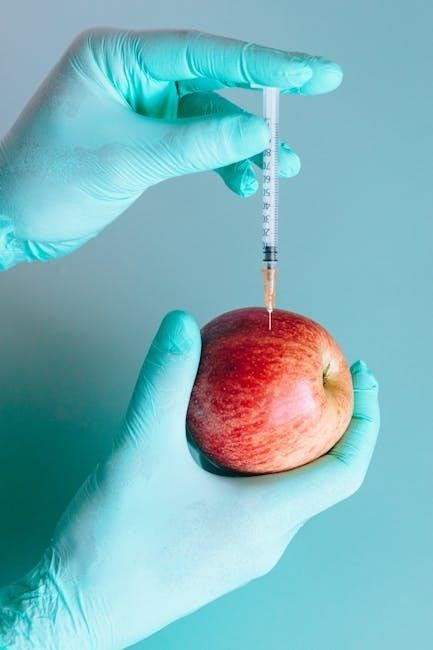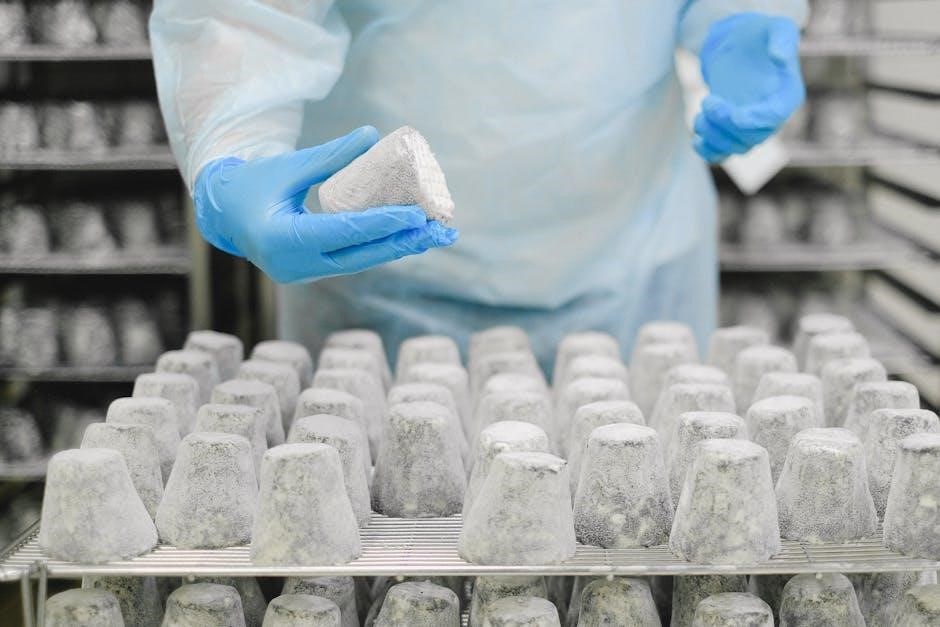The Level 2 Food Hygiene Test is a foundational certification for food handlers, ensuring compliance with food safety standards and promoting safe food preparation practices.
Overview of the Test
The Level 2 Food Hygiene Test is a standardized assessment designed to evaluate an individual’s understanding of essential food safety practices. It covers key areas such as food poisoning prevention, personal hygiene, and safe food handling procedures. The test typically consists of multiple-choice questions, with a focus on practical scenarios encountered in food environments. Candidates are required to demonstrate their ability to apply food hygiene principles effectively. The test is usually timed, lasting between 30 to 45 minutes, depending on the provider. A passing score is often around 70-80%, ensuring a solid grasp of food safety fundamentals. This certification is a legal requirement for many food handlers, making it a crucial step in maintaining workplace safety and compliance with regulations.
Importance of Food Hygiene Certification
Food hygiene certification is essential for ensuring the safety and well-being of consumers. It equips food handlers with the knowledge to prevent foodborne illnesses, maintain clean environments, and adhere to legal standards. By obtaining this certification, individuals demonstrate their commitment to upholding high food safety practices, which builds trust with employers and customers. Additionally, it minimizes the risk of legal penalties for non-compliance, protecting both businesses and employees. The certification also enhances career prospects, as it is often a mandatory requirement in the food industry. Ultimately, food hygiene certification plays a vital role in promoting public health and maintaining the integrity of the food supply chain.

Key Topics Covered in the Level 2 Food Hygiene Test
The test covers essential food safety areas, including food poisoning prevention, personal hygiene practices, safe food storage and preparation, and proper use of date marks and labeling.
Food Poisoning and Food Safety Awareness
Understanding food poisoning causes and prevention is crucial for maintaining food safety. Common bacteria like E. coli, Salmonella, and Listeria can lead to severe illness if food is improperly handled. Recognizing symptoms of foodborne illnesses and implementing preventive measures, such as proper handwashing and temperature control, are emphasized. Safe food handling practices include separating raw and cooked foods to avoid cross-contamination and ensuring food is cooked to the recommended temperature. Awareness of high-risk groups, such as the elderly and young children, is also covered. By understanding these principles, food handlers can significantly reduce the risk of food poisoning, ensuring a safer environment for consumers.
Good Personal Hygiene Practices
Good personal hygiene is essential for maintaining food safety and preventing contamination. This includes washing hands thoroughly with soap and warm water before handling food, after using the restroom, and after touching raw ingredients or contaminated surfaces. Hands should be dried with clean, disposable towels or hand dryers. Cuts or wounds must be covered with waterproof dressings, and gloves should be worn if necessary. Food handlers should wear clean, appropriate clothing, including a clean uniform and hair covering if required. Jewelry should be kept to a minimum to avoid contamination risks. Personal hygiene also involves avoiding touching the face, mouth, or hair while handling food. Maintaining good personal hygiene practices ensures a clean and safe food preparation environment, reducing the risk of foodborne illnesses.

Safe Storage, Preparation, and Cooking of Food
Proper storage, preparation, and cooking of food are critical to maintaining food safety and preventing contamination. Food should be stored in clean, covered containers at appropriate temperatures, with raw and ready-to-eat foods kept separate to avoid cross-contamination. Chilled foods must be stored at 5°C or below, while frozen items should be kept at -18°C or lower. During preparation, utensils and surfaces must be cleaned and sanitized regularly. Cooking requires ensuring that food reaches a minimum internal temperature of 75°C to kill harmful bacteria. Reheated food should reach at least 82°C to ensure safety; Correct defrosting methods, such as thawing in the refrigerator or under cold running water, are essential to prevent bacterial growth. Proper food handling during storage, preparation, and cooking ensures a safe and hygienic food environment, reducing the risk of foodborne illnesses and contamination.
Use of Date Marks and Food Labeling
Understanding the use of date marks and food labeling is essential for maintaining food safety and hygiene standards. Food products are labeled with “Use By” or “Best Before” dates to guide consumers on safety and quality. The “Use By” date indicates the last safe consumption day, while “Best Before” refers to quality, not safety. Proper labeling ensures traceability and helps prevent foodborne illnesses. Food handlers must adhere to these markings to avoid serving unsafe or spoiled food. Correct storage based on labeling instructions is crucial for maintaining food quality and safety. This practice also supports legal compliance and consumer trust. Accurate date marking and labeling are vital for reducing contamination risks and ensuring food is handled responsibly throughout its lifecycle.

Test Format and Structure
The Level 2 Food Hygiene Test typically consists of a multiple-choice format, assessing knowledge on food safety practices, regulations, and hygiene standards to ensure competency in handling food safely.
Question Types and Time Limits
The Level 2 Food Hygiene Test features multiple-choice questions designed to evaluate understanding of food safety principles. Candidates typically have a limited time frame to complete the exam, ensuring they can apply their knowledge effectively under timed conditions. The structure is straightforward, with each question offering several options, only one of which is correct. This format helps assess both accuracy and speed, essential skills for real-world food handling scenarios. Proper time management is crucial to answer all questions within the allotted time, demonstrating a balance between thoroughness and efficiency. Understanding the question types and time constraints beforehand allows candidates to prepare more effectively for the test.

Passing Score and Certification
Achieving a passing score on the Level 2 Food Hygiene Test typically requires answering at least 70-75% of the questions correctly. Upon successful completion, candidates receive a recognized certification, valid for a specified period. This certificate confirms their understanding of essential food safety practices and legal responsibilities. The certification is widely accepted across the food industry, including restaurants, cafes, and food retail environments. It is important to note that the specific passing score may vary slightly depending on the test provider. Renewal of the certification is usually required after a certain number of years to ensure ongoing compliance with updated food safety standards and regulations. Obtaining this certification is a critical step for anyone working in food handling roles.

Study Materials and Resources
Recommended textbooks, online practice tests, and video tutorials provide comprehensive preparation. The Answer Key for Level 2 Food Safety & Hygiene from September 2017 is also available.
Recommended Textbooks and Guides
Several textbooks and guides are available to aid preparation for the Level 2 Food Hygiene Test. The Level 2 Award in Food Safety & Hygiene textbook is highly recommended, offering detailed insights into food safety laws and best practices. Additionally, the Answer Key for Level 2 Food Safety & Hygiene from September 2017 provides specimen answers, helping candidates understand expected response formats. These resources cover key topics such as food poisoning prevention, personal hygiene, and safe food handling. Many guides include interactive exercises and real-world scenarios to enhance learning. They are designed to align with current food safety standards, ensuring comprehensive understanding. Using these materials ensures candidates are well-prepared for the test and beyond.
Online Practice Tests and Quizzes
Online practice tests and quizzes are excellent tools for preparing for the Level 2 Food Hygiene Test. Websites like High Speed Training and City & Guilds offer free quizzes that cover essential topics such as food poisoning prevention, personal hygiene, and safe food handling. These resources help identify knowledge gaps and improve understanding of key concepts. Many platforms provide instant feedback, allowing candidates to track their progress. Practice tests often include multiple-choice questions similar to those found in the actual exam, ensuring familiarity with the format. Regular use of these tools can significantly enhance confidence and readiness for the test. They are particularly useful for self-study and reinforcing learning from textbooks or classroom instruction. Utilizing online quizzes is a convenient and effective way to prepare for certification.
Video Tutorials and Interactive Learning Tools
Video tutorials and interactive learning tools are highly effective for mastering the Level 2 Food Hygiene Test. Platforms like YouTube and Khan Academy offer video guides that break down complex topics into digestible segments. These tutorials often include animations and real-life scenarios, making learning engaging and relatable. Interactive tools, such as quizzes and simulations, allow learners to test their knowledge in a hands-on way. Websites like High Speed Training provide interactive modules that simulate exam conditions, helping candidates familiarize themselves with the test format. These resources are particularly useful for visual and kinesthetic learners, as they combine practical examples with theoretical knowledge. By leveraging these tools, candidates can reinforce their understanding of food safety principles and feel more confident on test day.
Preparation Tips for the Test
Create a study plan, focusing on key topics like food poisoning and hygiene practices. Practice with past papers to understand answer patterns and manage time effectively.

Stay calm, read questions carefully, and ensure thorough preparation for optimal performance in the Level 2 Food Hygiene Test.
Understanding the Answer Patterns
Understanding the answer patterns in the Level 2 Food Hygiene Test is crucial for success. The test typically includes multiple-choice questions, true/false statements, and short-answer responses. Many questions focus on identifying correct food safety practices, such as safe storage temperatures and hygiene procedures. Answers often require selecting the most appropriate option or providing a concise explanation. Practicing with sample questions helps familiarize yourself with the format and content. Reviewing answer keys from past papers provides insights into common question types and expected responses. This preparation ensures you can recognize and apply knowledge effectively during the test. By mastering these patterns, you enhance your ability to respond accurately and efficiently, improving overall performance. Proper understanding of answer patterns is key to achieving certification and ensuring food safety standards are met.
Time Management Strategies

Effective time management is essential for success in the Level 2 Food Hygiene Test. Allocate a specific amount of time to each question to ensure you complete the test within the allowed duration. Skim through the entire paper first to identify easier questions and tackle them early, saving time for more challenging ones later. Practice mock tests under timed conditions to build confidence and improve speed. Prioritize answering questions you are certain about to secure guaranteed points. Avoid spending too long on a single question, as it may cause you to rush through the remaining ones; Use the process of elimination to narrow down options for uncertain answers. By managing your time wisely, you can maintain focus and achieve the best possible results. Regular practice helps refine these strategies, ensuring efficient use of time during the actual test.
Common Mistakes to Avoid
When preparing for the Level 2 Food Hygiene Test, it’s crucial to avoid common pitfalls that can hinder success. One major mistake is misinterpreting question wording, leading to incorrect answers. Candidates often overlook specific details in scenarios or confuse similar-sounding options. Another error is poor time management, resulting in rushed responses or incomplete answers. Some individuals may rely too heavily on guesswork rather than applying learned knowledge. Additionally, neglecting to review answers before submitting can lead to avoidable mistakes. To avoid these errors, read questions carefully, manage time effectively, and ensure a thorough review of responses. Regular practice with mock tests can help identify and rectify these common mistakes, improving overall performance and confidence. By addressing these issues, candidates can approach the test more effectively and achieve better results. Proper preparation and attention to detail are key to success.

Legal Responsibilities and Best Practices
Understanding food safety laws and implementing best practices are essential for legal compliance and maintaining high food hygiene standards in the food industry. Continuous learning ensures adherence.
Understanding Food Safety Laws
Food safety laws are designed to protect public health by ensuring safe food handling practices. These regulations outline the responsibilities of food establishments to maintain hygiene standards, proper food storage, and accurate labeling. Compliance with food safety laws is mandatory for all food handlers, from preparation to serving. Understanding these laws is crucial for avoiding legal penalties and ensuring consumer safety. Key aspects include temperature control, cross-contamination prevention, and proper waste disposal. Staying informed about updates to food safety legislation is essential for maintaining compliance and providing a safe environment for customers. Training, such as the Level 2 Food Hygiene Test, helps individuals grasp these legal requirements effectively. Adherence to these laws not only protects public health but also enhances the reputation of food businesses. Regular audits and inspections ensure that food safety laws are consistently followed. By understanding and implementing these laws, food handlers contribute to a safer and healthier community.
Implementing Best Practices in Food Handling
Implementing best practices in food handling is essential for maintaining food safety and preventing contamination. This includes proper handwashing, wearing protective clothing, and ensuring all utensils and surfaces are clean. Separating raw and ready-to-eat foods is crucial to avoid cross-contamination. Proper temperature control during storage, preparation, and serving is vital, as bacteria thrive in unsafe temperature zones. Regular cleaning and sanitizing of equipment and work areas are necessary to eliminate pathogens. Additionally, staff should be trained to follow these practices consistently. Using date marks and ensuring food is not past its safe consumption date is another critical aspect. By adhering to these best practices, food handlers can reduce the risk of foodborne illnesses and ensure a safe dining experience for customers. Continuous monitoring and improvement of these practices are key to maintaining high food safety standards.

Post-Test Actions
After passing the Level 2 Food Hygiene Test, candidates receive a certificate, which is valid for three years. It is essential to renew the certification by retaking the test before the expiration date to maintain compliance with food safety regulations. Additionally, continuous learning through updated study materials and refresher courses is recommended to stay informed about the latest food safety practices and legal requirements. Employers often require this certification as part of their food safety protocols, ensuring a safe working environment and protecting public health. Candidates should also keep their certificates updated and readily available for inspection by health authorities; Proper documentation and record-keeping are crucial for both individuals and organizations to demonstrate adherence to food safety standards.
Obtaining the Certificate
Upon successfully completing the Level 2 Food Hygiene Test, candidates are issued a certificate, which is typically provided in digital format via email. This certificate serves as proof of their understanding of food safety principles and compliance with legal requirements. The certificate is valid for three years, after which it must be renewed by retaking the test. Employers often require this certification as part of their hiring process, especially in roles involving food preparation or handling. It is essential to keep both digital and printed copies of the certificate for verification purposes. The certificate also enhances career opportunities in the food industry by demonstrating a commitment to food safety standards.
Renewal and Continuous Learning
The Level 2 Food Hygiene Certificate must be renewed every three years to ensure ongoing compliance with food safety standards. Renewal involves retaking the test to stay updated on the latest regulations and best practices. Continuous learning is crucial in the food industry, as laws and guidelines often evolve. Employers may require periodic refresher courses or additional training to maintain certification. Staying informed through workshops, online resources, and updated study materials helps food handlers adapt to new standards. Continuous learning not only reinforces essential skills but also demonstrates a commitment to food safety, enhancing job prospects and ensuring consumer trust. Regular updates and renewals are vital for maintaining a safe and hygienic food environment.
